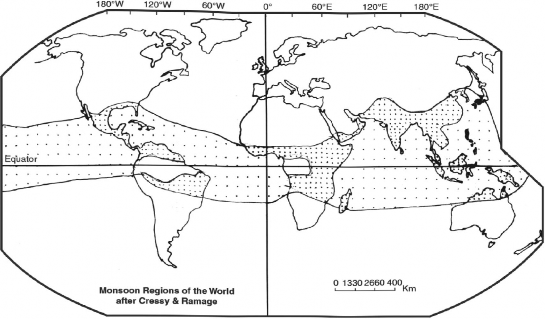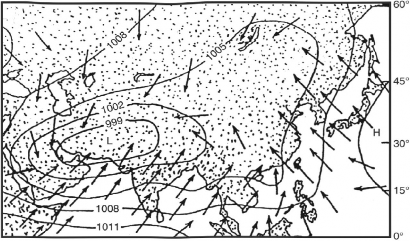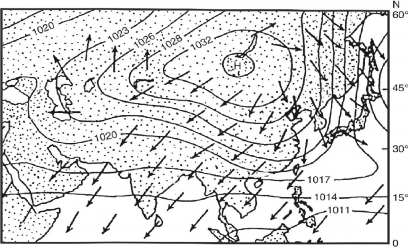The Thermal Concept of Halley (1686)
Halley, a noted astronomer, hypothesised that the primary cause of the annual cycle of the Indian monsoon circulation was the differential heating effects of the land and the sea. According to this

Fig. 4.1 Monsoon Regions of the World
concept monsoons are the extended land breeze and sea breeze on a large scale, produced by the differential heating of continents and ocean basins (Fig. 4.2). During the summer season in the Northern Hemisphere, when the Sun’s rays are vertical over the Tropic of Cancer, the huge landmass of Asia heats quickly and develops a strong low pressure centre near Lake Baikal (Siberia) and Peshawar (Pakistan). This thermal low extends up to 700 mb. Moreover, the pole-ward shift of the Inter-Tropical Convergence Zone (ITCZ) to a position over southern Asia reinforces the thermally induced low pressure centre. In comparison to this, the pressure over the adjacent water of the Indian and the Pacific Oceans is relatively high. Under these conditions, a sea-to-land pressure gradient develops. Consequently, the surface air flow is from the high pressure over the oceans towards the low pressure areas over the heated landmass. Under the extreme low pressure condition on land, the wind from the southern part of the Indian Ocean (south of Equator) is attracted towards the subcontinent of
WINTER
SUMMER
South-west
Land Breeze Night time cycle North east trade

North east trade
Sea Breeze Day time cycle

Equator warm
India cool
Equator India
warm hot
Peninsular Rivers
1. The rivers of Peninsular India are much older. Some of them are as old as the Pre-Cambrian Period.
2. They are mostly consequent or rejuvenated rivers.
3. These rivers, except Godavari, have relatively small basins.
4. The channels of these rivers are broad.
5. There is hardly any vertical erosion.
6. These are slow moving.
7. The se have low carrying capacity.
8. These are mainly depositional agents.
9. They make shallow meanders.
10. These are generally not navigable.
11. These are mostly seasonal.
12. Most of them originate from the Western Ghats and plateaux.
13. Most of them are in the senile stage.
14. There is no river capturing.
15. These rivers have been harnessed for the generation of hydel-power, e.g. Hirakund, Koyna, Nagarjunasagar.
16. These rivers make deltas (Godavari, Krishna, Kaveri) and estuaries like Narmada and Tapi.
17. Their channels are near the base level.
Extra-Peninsular Rivers
1. The rivers of the Extra-Peninsular India are much younger, excepting a few antecedent rivers like Indus, Satluj, Ganga, Brahmaputra, etc.
2. Many of them like Indus, Satluj, Kali, Ko si, Brahmaputra, Tista are inconsequent rivers.
3. These rivers generally have large basins.
4. The channels of these rivers in the upper courses form gorges waterfalls, and rapids.
5. Both vertical and lateral erosions are significant.
6. These are both swift and have sluggish movements.
7. They transport huge quantities of sediments.
8. These are active erosional and depositional agents.
9. In the plains, they make numerous sharp meanders and ox-bow lakes.
10. Most of them are navigable in the plains.
1). These are perennial.
12. Most of them originate from the Himalayan Glaciers.
13. Most of them are in the late youth stage.
14. River capturing is a common phenomenon.
15. There are numerous multipurpose projects on these rivers, e.g. Bhakra, Tehri, Salal, etc.
16. These rivers make only deltas. The Sundarban Delta is the largest in the world.
17. These rivers are in the ending part of youth stage. In their mountainous course they do river capturing.
Fig. 4.2 Land Breeze and Sea Breeze: Monsoon Cycle
India. The air coming from oceans towards land is warm and moist. When land barriers like mountain ranges and plateaus come in the way of the moisture- laden winds, they ascend and result into saturation, condensation, and precipitation (Fig.4.3).
N

July
Fig. 4.3 The Summer Monsoon
Contrary to this, in the Northern Hemisphere dur ing winter season, there develops high pressure areas near Baikal Lake (Siberia), and Peshawar (Pakistan). As compared to these high pressures, the Indian Ocean and the Pacific Ocean (south ofjapan) remain relatively warm, having low pressure areas. Consequently, there is an outflow of air from the high pressure of the land to the low pressure areas of the oceans. The air blowing from high pressure areas of land towards the sea is cold and dry. This cold and dry air is incapable of giving precipitation unless it comes into contact with some water body (ocean/sea) (Fig. 4.4)
The thermal concept about the origin of monsoon has, however, not been accepted universally as it fails to explain the intricacies of monsoon. Besides differential heating, the origin and development of monsoon are also influenced by the shape of the continents, orography, and the conditions of air circulation in the upper troposphere. The Halley’s concept has been criticised on more than one count as follows:
1. The low pressure areas that develop over the continents during the summer season in the Northern Hemisphere are not stationary. These low pressure areas change their position (location) suddenly. This sudden change in the low pressure areas are not exclusively related to low thermal conditions. The low pressure areas stabilises in June in the north-eastern parts of the subcontinent. In fact, they represent the cyclonic lows associated with the dynamic factors, and therefore, these low pressure areas cannot be termed as only thermally induced.
2. Had the monsoon been thermally induced, there would be anti-monsoon circulation in the upper air of the troposphere, which is lacking.
3. Although high temperature and the consequent low pressure takes the north-west in its grip from the middle of April, no rain starts in northern India till the middle ofjune.
4. The modern researches in meteorology have shown that the monsoon rainfall is not wholly orographic. They are an amalgamation of convectional, orographic and cyclonic rainfall.
5. Instead of two broad seasons (winter and summer) the monsoon climate has more seasons (four in India), due to the highly variable characteristics of temperature and precipitation.
6. Halley did not take into consideration the Coriolis effect of rotation of the earth on its axis. On a rotating earth, the wind has a tendency to move towards its right in the Northern Hemisphere and towards its left in the Southern Hemisphere.
7. The role of latent heat passing into the atmosphere through water vapour was also not considered by Halley; water vapour also plays an important role in the origin and development of monsoons.
The Asiatic Monsoon Winds

January
